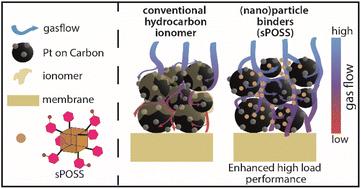无氟磺化多面体低聚硅氧烷:取代燃料电池催化剂层中的聚合粘合剂
IF 9.5
2区 材料科学
Q1 CHEMISTRY, PHYSICAL
引用次数: 0
摘要
向无氟燃料电池过渡的关键之一是开发用于膜和电极的无氟离子单体。有前途的材料,如磺化苯基化聚苯乙烯(sPPP)(如Pemion®)和磺化聚苯砜(sPPS),表现出低气体交叉,使其适用于膜应用。然而,最近的研究表明,它们的低透气性加上潮湿条件下的高溶胀性使其在电极中的使用复杂化,特别是在高电流密度下。然而,在这项研究中,我们探索了笼状磺化多面体低聚硅氧烷(sPOSS)作为质子导电材料和电极粘合剂。我们展示了使用sPOSS制造稳定电极的方法,其在动力学区域表现出与烃基离聚物(如sPPP)相当的性能,同时在高电流密度下表现优于sPPP,这可能是由于改善了气体输运特性。本文章由计算机程序翻译,如有差异,请以英文原文为准。

Fluorine-free sulfonated polyhedral oligomeric silsesquioxanes: replacing polymeric binder in fuel cell catalyst layers
One of the key points in transitioning to fluorine-free fuel cells is the development of fluorine-free ionomers for both membranes and electrodes. Promising materials, such as sulfonated phenylated polyphenylenes (sPPP) (e.g., Pemion®) and sulfonated polyphenylene sulfones (sPPS), demonstrate low gas crossover, making them suitable for membrane applications. However, recent studies suggest that their low gas permeability combined with high swelling under humid conditions complicates their use in electrodes, particularly at high current densities. In this study, however, we explore cage-like sulfonated polyhedral oligomeric silsesquioxanes (sPOSS) as a proton-conductive material and electrode binder. We demonstrate the fabrication of stable electrodes using sPOSS, which exhibit performance comparable to hydrocarbon-based ionomers like sPPP in the kinetic region while outperforming it at high current densities, likely due to improved gas transport properties.
求助全文
通过发布文献求助,成功后即可免费获取论文全文。
去求助
来源期刊

Journal of Materials Chemistry A
CHEMISTRY, PHYSICAL-ENERGY & FUELS
CiteScore
19.50
自引率
5.00%
发文量
1892
审稿时长
1.5 months
期刊介绍:
The Journal of Materials Chemistry A, B & C covers a wide range of high-quality studies in the field of materials chemistry, with each section focusing on specific applications of the materials studied. Journal of Materials Chemistry A emphasizes applications in energy and sustainability, including topics such as artificial photosynthesis, batteries, and fuel cells. Journal of Materials Chemistry B focuses on applications in biology and medicine, while Journal of Materials Chemistry C covers applications in optical, magnetic, and electronic devices. Example topic areas within the scope of Journal of Materials Chemistry A include catalysis, green/sustainable materials, sensors, and water treatment, among others.
 求助内容:
求助内容: 应助结果提醒方式:
应助结果提醒方式:


